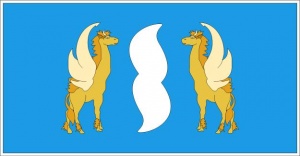Difference between revisions of "Gontha"
Trismegistus (talk | contribs) m (→Breeds) |
Trismegistus (talk | contribs) m |
||
| Line 34: | Line 34: | ||
*[[Tosplint Tree]] | *[[Tosplint Tree]] | ||
| − | [[Category:Fauna]] | + | [[Category:Fauna of Asdar]] |
[[Category:Fauna of the Jaggudorn Mountains]] | [[Category:Fauna of the Jaggudorn Mountains]] | ||
{{stub}} | {{stub}} | ||
Revision as of 11:35, 29 July 2017
A Gontha is a flying herbivore that resembles a herd animal with the frame of a yak and the longish neck of a giraffe, but somewhat more squat and covered with woolly fur. Gontha graze in the summer on high altitude pasturage and in the winter on the rich foliage of the Tosplint Tree near the Shadew River. Gontha herds provide meat, milk, and fur for many traditional sky peoples. The creature's long neck has long been accredited in legend as the source of its capacity to fly and enables it to reach leaves from the tall, deciduous trees of the Jaggudorn valleys during the winter. In the summer, the gontha eat high altitude grasses, even from the sides of mountains, with their high-reaching necks. Today gontha are shipped throughout the Pallathantic Region thanks to the Grand Shadew Canal. A gontha stands between 11 and 15 feet high and weights around 3,000 pounds.
Economic Worth
Gontha cows produce a thick, creamy milk and provide a flesh that tastes something like buffalo and deer. Their fur is used to create wool of great warmth and for skysails. Gontha were domesticated by the Jaffgorn Giants millennia before the advent of Salmakhamer and can fly for several days at a time, though they only do this when migrating to new pasturage as they must rest and gorge themselves with food thereafter. Gontha are an important part of the economy of the ancient and modern sky peoples of Jaggudorns. Anciently, they were prized as sources of wealth as food, fur, hides, bones, and sacrifice to the gods. The royal herds of the king were guarded as the king’s treasury. Gontha breed in autumn and birth in late spring or early summer. During the harsh winters of the Jaggudorns, gontha are herded to the great Shadew River Valley where they graze on the leaves of the deciduous Tosplint Trees. They live the other five months of the Asdaran Calendar in the lush foothills of the Jaggudorns. A mother gontha gives birth to one or two calves typically every year. A gontha is almost as intelligent as a buffalo, but more docile. Humans, Uglyami, Mountain Orcs, and Trolls have practiced gontha herding for well over two millennia. Gontha have only recently been domesticated, so they are not as tame as conventional domestic cattle.
Development of Early Skycraft
The early High Shadevan Tribes and the later Jaggudornish Tribes (the intermediary culture between the Ancient High Gwenyan and the later Sky Tribes) came to rely upon the gontha for sustenance. The High Shadevan Tribes hunted the beasts, but never overcame the their capacity for short-range flight which rendered attempts at herding and captivity useless. Sometime after their immigration into the Great Vale of the Shadew River, the High Gwenyan Tribes developed the technology to herd the beasts. The Jaggudornish Tribes developed the cultivation of woods and fabrics that could be used to create short-ranged, aerial gliders. Now with the aid of the one- and two-man gliders, the Jaggudornish Tribes could herd the Gontha up into the mountain valleys and back down to the Great Vale of the Shadew. The humans could exploit the gontha. The gontha became an enormous, reliable resource for the tribes and they expanded in population, nudging out the decaying High Shadevan Civilization. The development of early sky gliders eventually led through the centuries to the development of huge sky vessels and the emigration and dominance of the Sky Tribes a thousand years later over the other humanlikes of the Jaggudorns.
Gontha Wool
Gontha wool was sought for its softness and warmth. Lighter than other wools, the wool produced from yearling gontha is preferred for the weaving of skysails. It is not as effective as skysails from textiles from tursinkdoos, but cheaper.
Breeds
There are several breeds.
- Bosk Gontha
- a short-haired, green and brown speckled gontha
- Holy Gontha
- a golden, long-haired gontha of the deep Jaggudorns, thought to be sacred to the gods
- Jaggue Gontha
- the grey-haired gontha of the rocky Jaggudorns known for their sure-footedness and very high resistance to cold. Their wool is heavier and less favored for skysails.
- Snee Gontha
- long white haired gontha with the greatest tolerance for high elevations
Gontha in Art
In the great valleys between the Jaggudorns and the Shadew River, the Gonthais revered with its own divinity. In Thrace, gontha were portrayed stylistically as vertically exaggerated beasts with one or two pairs of wings that represented their ability to fly. In heraldry, they are called camelopards. The flag of Shaddago has two stylized, winged gontha on it.

Idioms
"Stick out like a gontha in the grass." Something readily obvious to observe. A gontha looks like a giraffe.
See Also
| This article is a stub. It requires further development by the creator. |